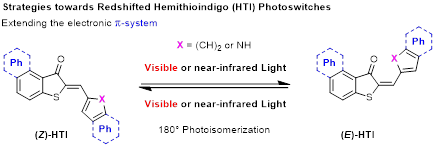Using light as an external stimulus is advantageous over other stimuli, because it is non-invasive over a wide range of wavelengths, and displays high spatial and temporal precision when delivered. Unlike additives, there is no need for its removal afterwards, which simplifies the process and lowers the cost.
Furthermore, it is possible to tune the wavelength and intensity of light to match the intended application. With this in mind, light has found numerous uses as an external stimulus to trigger or control events in photochemical applications, such as the spatial geometry and properties of molecular photoswitches in addition to mediating chemistry in drug discovery as exemplified in this thesis. Molecular photoswitches comprise a class of molecules able to interconvert reversibly between a stable and metastable isomer upon absorption of light, which can be exploited similar to an “ON”/”OFF” switch to control biological functions or as a system to store solar thermal energy.
A limitation with current molecular photoswitches is the need for low wavelength UV light to initiate the switching process, as the associated energy is sufficiently high to cause photodegradation of the switch itself, but also of the surrounding material, which for biological applications is less favourable. Redshifting the wavelengths of absorption towards the low-energy red part of the visible electromagnetic spectrum through molecular tailoring serves as a viable strategy in developing new and improved systems. In this context, it enabled the development of hemithioindigo photoswitches with improved photophysical properties in which the absorption was substantially redshifted to facilitate switching with near-infrared light of great value for future applications related to photopharmacology.
As previously described, light may also be employed to conveniently mediate chemistry, and in connection to this, a simple and inexpensive semi-automated photochemical screening platform was developed and applied to expedite the discovery of new photochemical transformations. It enabled parallel screening of reactions in 96-well microtitre plates to discover the most optimal reaction conditions facilitating product formation. This high-throughput experimentation approach far outcompetes the discovery capabilities of the one-at-a-time classical batch approach used as a standard for chemical synthesis when comparing rates of output. In this context, the platform was exploited to discover a new triplet-sensitized photochemical [2+2] cycloaddition reaction that will later set up the synthesis of an alkaloid-inspired natural product-like compound library, with potential applications drug in discovery.
